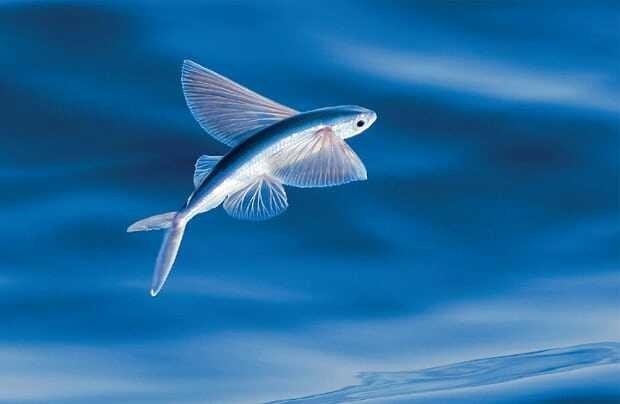Who does not know flying fish? Looking at the name alone, we certainly already know what makes this fish look so special when compared with other fish. Yup, this fish can fly outside the water. Flying fish is also famous for being the symbol of one of the private TV stations in Indonesia. And when people see flying fish, the usual question comes out: how does a fish that in fact a water creature can fly in the air? If a visitor is one of those people who has such a question, let this article answer the visitor's curiosity.

Flying fish (flying fish) or fish torani is a fish that gets the name so thanks to its ability to fly while out of water. Well, actually this fish does not really fly, but only limited to float. This will be discussed elsewhere in this article. There are 40 species of fish categorized as flying fish & all belong to the family Exocoetidae. The size of the flying fish body varies between species, but the largest is known to have a maximum body length of 45 cm.
Hands of flying fish. (Source) All species of flying fish are saltwater fish that live near the water surface. The spread of flying fish is widespread as these fish can be found in the tropical waters of the Indian Ocean, Pacific, & Atlantic. Food from flying fish is plankton & sometimes small fish. Flying fish have a clustered lifestyle & do not have a specific breeding season so flying fish can basically make a marriage anytime. After marriage, the female fish will attach its eggs to the floating objects at sea level. When compared with adult flying fish, fly fish boys have longer-lasting bodies & colorful fins.

The physical appearance of flying fish is essentially no different from the pelagic sea fish in general. Flying fish has a long & flat body, double-tailed triangular tail fin, upper body is dark blue, & silver bottom body. The typical physical features of flying fish are a pair of large, folded pectoral fins on the side of his body. The pectoral fins are the main instruments used by flying fish as they float out of water. Some species of flying fish also have a pair of large belly fins so that when floated, the fish is concerned as if it has 4 wings.
- BEGIN TO BE SAFE

The main enemies of flying fish are large animals that can swim fast like tuna, marlin, & dolphins. To defend themselves, flying fish utilize contrasting coloration of the body so it is difficult to see from both above and below by its enemies. But if the enemy managed to find the position of flying fish, then this fish take advantage of its unique ability: float out of water. At first, the flying fish will swim as fast as possible to the surface of the water. Once it has reached the surface, flying fish will jump & stretch its broad pectoral fin so that the fish looks as though it were flying.

If flying with pectoral fins
that folded. (Source) Flying fish can reach a height of 1.2 m, 400 m distance, and speed of 16 km / h while flying. Because flying fish are basically aquatic animals & only float while out of water, flying fish can only survive in the air for a few seconds before then fall back into the water. But if conditions in the sea are still dangerous, flying fish will wag its tail while on the surface of the water so that the fish can re-float in the air. Not infrequently flying fish fell stranded on the deck of the ship while it was flying.

In the waters where life, flying fish including the type of fish that are often caught because the eggs are expensive. To lure the fish to get stuck in the net, the fishermen usually wear light or torch when they are fishing at night. The caught fish is then stored in a tub of shallow water so the flying fish does not have enough room to float back to the sea. It is not known the exact amount of flying fish in the wild. But their numbers are estimated to be abundant so there is no specific regulation that regulates the maximum number of flying fish that can be caught.
Hi! I am a robot. I just upvoted you! I found similar content that readers might be interested in:
https://en.wikipedia.org/wiki/Flying_fish